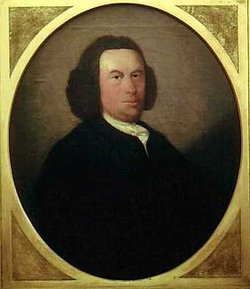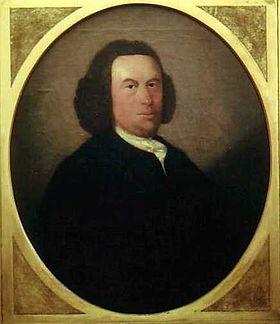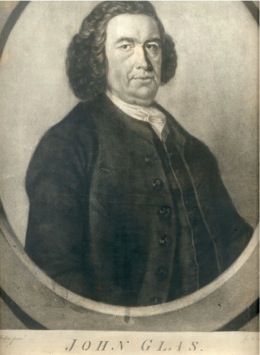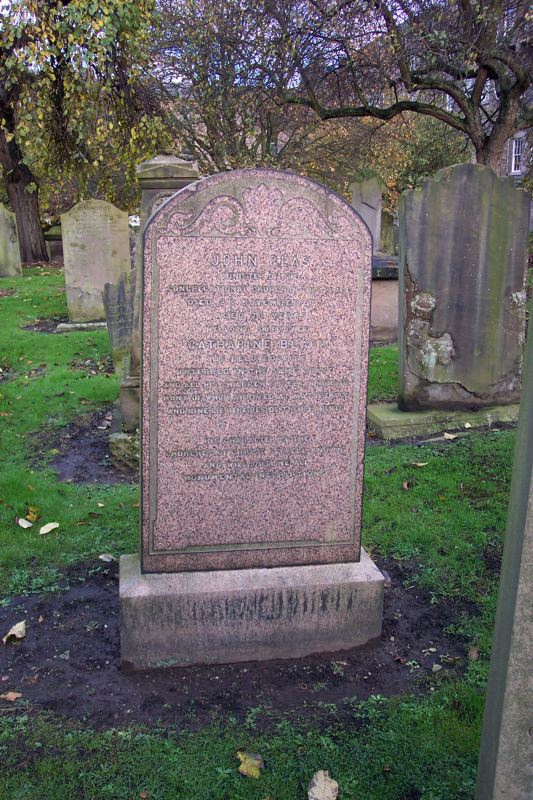to get back to the church recorded in the Bible. Glas started churches in Scotland, Wales and England. His son-in-law, Robert Sandeman, brought the movement to America. The Dundee Glasite church, c1730, was known as "The Kail Kirk" because of the worshiper's practice of dining together between services on sundays. The building is, today, within the facilities of the St. Andrews Church of Scotland, who maintain it's structure, and the Glasite Museum within.
John Glas is buried in "The Howff," a cemetery in Dundee. On his grave marker
reads; "His character in the Churches of Christ is well known and will outlive all
monumental inscription." His grave site is in the west-central section of "The Howff." Also in "The Howff," by the western wall, is the grave of James Thompson who died in 1786. Thompson was a Glasite minister at Kingoldrum, Scotland to the year 1781. His monument is horizontal and in the shape of a low table.
John Glas, (1695-1773), was expelled from the established church of Scotland in 1728 for reforming activities. He established a church of Christ in Dundee in 1732, followed by one in Perth in 1733 and one in Edinburgh in 1755. The Edinburgh building, constructed in 1835, is on the corner of Barony Street and Albany Lane, with a meeting hall, dining hall and a kitchen. The Glasite brethren had a practice of dining between Sunday services, thus, they were termed "The Kali Kirk." At the time of John Glas' death in 1773, there were more than thirty other congregations in Scotland, Yorkshire, London and America. - Paul E. Garrett, Where the Saints Trod in Great Britain.
∼John Glas was a Scottish clergyman who started the Glasite church movement.
He was born at Auchtermuchty, Fife, where his father was parish minister. He was educated at Kinclaven and Perth Grammar School, graduated from the University of St Andrews in 1713, and completed his education for the ministry at Edinburgh. He was licensed as a preacher by the presbytery of Dunkeld, and soon afterwards ordained by that of Dundee as minister of the parish of Tealing (1719), where his preaching soon drew a large congregation. Early in his ministry he was brought to a halt while lecturing on the Shorter Catechism by the question "How doth Christ execute the office of a king?" This led to an examination of the New Testament foundation of the Christian Church, and in 1725, in a letter to Francis Archibald, minister of Guthrie, Forfarshire, he repudiated the obligation of national covenants.
In the same year he formed a society separate from the multitude, numbering nearly a hundred, and drawn from his own and neighbouring parishes. The members of this ecclesiola in ecclesia pledged themselves to join together in the Christian profession, to follow Christ the Lord as the righteousness of his people, to walk together in brotherly love, and in the duties of it, in subjection to Glas as their overseer in the Lord, to observe the Lord's Supper once a month and to submit themselves to the Lord's law for removing offences. From the scriptural doctrine of the essentially spiritual nature of the kingdom of Christ, Glas in his public teaching drew the conclusions that: there is no warrant in the New Testament for a national church
the magistrate as such has no function in the church
National Covenants are without scriptural grounds
the true Reformation cannot be carried out by political and secular weapons but by the word and spirit of Christ only
This argument is most fully exhibited in a treatise entitled The Testimony of the King of Martyrs (1729). For the promulgation of these views, which were at variance with the doctrines of the national church of Scotland, he was summoned (1726) before his presbytery, where in the course of being investigated, he affirmed his belief that every national church established by the laws of earthly kingdoms is anti-Christian in its constitution and persecuting in its spirit, and further declared opinions upon the subject of church government which amounted to a repudiation of Presbyterianism and an acceptance of the puritan type of Independence.
For these opinions he was in 1728 suspended from his ministerial functions, and finally deposed in 1730. The members of the society already referred to, however, for the most part continued to adhere to him, thus constituting the first Glassite or Glasite church. The seat of this congregation was shortly afterwards transferred to Dundee (whence Glas subsequently removed to Edinburgh), where he officiated for some time as an elder. He next labored in Perth for a few years, where he was joined by Robert Sandeman, who married his daughter Catherine — eventually Sandeman was recognized as the leader and principal exponent of Glas's views; these he developed in a direction which laid them open to the charge of antinomianism.
Ultimately in 1730 Glas returned to Dundee for the remainder of his life. He introduced in his church the primitive custom of the osculum pacis and the agape celebrated as a common meal with broth. From this custom his congregation was known as 'the kail kirk'. In 1739 the General Assembly, without any appeal from him, removed the sentence of deposition against him, and restored him to the status of a minister of the gospel of Christ, but not that of a minister of the Established Church of Scotland, declaring that he was not eligible for a charge until he should have renounced principles inconsistent with the constitution of the church.
Glas married Catherine Black, the eldest daughter of a Perth minister in 1721. The couple had a happy marriage and brought forth 15 children - all of whom predeceased him, as did his wife, who died of tuberculosis in 1749, 24 years before him. According to the accounts of the time, Glas was a most kind-hearted man, very fond of children, a most humane man, with not a trace of fanaticism or bigotry. One daughter Agnes Glas married Hector Turnbull who developed bleachfields in Luncarty near Perth. John Glas is buried at The Howff in Dundee.
to get back to the church recorded in the Bible. Glas started churches in Scotland, Wales and England. His son-in-law, Robert Sandeman, brought the movement to America. The Dundee Glasite church, c1730, was known as "The Kail Kirk" because of the worshiper's practice of dining together between services on sundays. The building is, today, within the facilities of the St. Andrews Church of Scotland, who maintain it's structure, and the Glasite Museum within.
John Glas is buried in "The Howff," a cemetery in Dundee. On his grave marker
reads; "His character in the Churches of Christ is well known and will outlive all
monumental inscription." His grave site is in the west-central section of "The Howff." Also in "The Howff," by the western wall, is the grave of James Thompson who died in 1786. Thompson was a Glasite minister at Kingoldrum, Scotland to the year 1781. His monument is horizontal and in the shape of a low table.
John Glas, (1695-1773), was expelled from the established church of Scotland in 1728 for reforming activities. He established a church of Christ in Dundee in 1732, followed by one in Perth in 1733 and one in Edinburgh in 1755. The Edinburgh building, constructed in 1835, is on the corner of Barony Street and Albany Lane, with a meeting hall, dining hall and a kitchen. The Glasite brethren had a practice of dining between Sunday services, thus, they were termed "The Kali Kirk." At the time of John Glas' death in 1773, there were more than thirty other congregations in Scotland, Yorkshire, London and America. - Paul E. Garrett, Where the Saints Trod in Great Britain.
∼John Glas was a Scottish clergyman who started the Glasite church movement.
He was born at Auchtermuchty, Fife, where his father was parish minister. He was educated at Kinclaven and Perth Grammar School, graduated from the University of St Andrews in 1713, and completed his education for the ministry at Edinburgh. He was licensed as a preacher by the presbytery of Dunkeld, and soon afterwards ordained by that of Dundee as minister of the parish of Tealing (1719), where his preaching soon drew a large congregation. Early in his ministry he was brought to a halt while lecturing on the Shorter Catechism by the question "How doth Christ execute the office of a king?" This led to an examination of the New Testament foundation of the Christian Church, and in 1725, in a letter to Francis Archibald, minister of Guthrie, Forfarshire, he repudiated the obligation of national covenants.
In the same year he formed a society separate from the multitude, numbering nearly a hundred, and drawn from his own and neighbouring parishes. The members of this ecclesiola in ecclesia pledged themselves to join together in the Christian profession, to follow Christ the Lord as the righteousness of his people, to walk together in brotherly love, and in the duties of it, in subjection to Glas as their overseer in the Lord, to observe the Lord's Supper once a month and to submit themselves to the Lord's law for removing offences. From the scriptural doctrine of the essentially spiritual nature of the kingdom of Christ, Glas in his public teaching drew the conclusions that: there is no warrant in the New Testament for a national church
the magistrate as such has no function in the church
National Covenants are without scriptural grounds
the true Reformation cannot be carried out by political and secular weapons but by the word and spirit of Christ only
This argument is most fully exhibited in a treatise entitled The Testimony of the King of Martyrs (1729). For the promulgation of these views, which were at variance with the doctrines of the national church of Scotland, he was summoned (1726) before his presbytery, where in the course of being investigated, he affirmed his belief that every national church established by the laws of earthly kingdoms is anti-Christian in its constitution and persecuting in its spirit, and further declared opinions upon the subject of church government which amounted to a repudiation of Presbyterianism and an acceptance of the puritan type of Independence.
For these opinions he was in 1728 suspended from his ministerial functions, and finally deposed in 1730. The members of the society already referred to, however, for the most part continued to adhere to him, thus constituting the first Glassite or Glasite church. The seat of this congregation was shortly afterwards transferred to Dundee (whence Glas subsequently removed to Edinburgh), where he officiated for some time as an elder. He next labored in Perth for a few years, where he was joined by Robert Sandeman, who married his daughter Catherine — eventually Sandeman was recognized as the leader and principal exponent of Glas's views; these he developed in a direction which laid them open to the charge of antinomianism.
Ultimately in 1730 Glas returned to Dundee for the remainder of his life. He introduced in his church the primitive custom of the osculum pacis and the agape celebrated as a common meal with broth. From this custom his congregation was known as 'the kail kirk'. In 1739 the General Assembly, without any appeal from him, removed the sentence of deposition against him, and restored him to the status of a minister of the gospel of Christ, but not that of a minister of the Established Church of Scotland, declaring that he was not eligible for a charge until he should have renounced principles inconsistent with the constitution of the church.
Glas married Catherine Black, the eldest daughter of a Perth minister in 1721. The couple had a happy marriage and brought forth 15 children - all of whom predeceased him, as did his wife, who died of tuberculosis in 1749, 24 years before him. According to the accounts of the time, Glas was a most kind-hearted man, very fond of children, a most humane man, with not a trace of fanaticism or bigotry. One daughter Agnes Glas married Hector Turnbull who developed bleachfields in Luncarty near Perth. John Glas is buried at The Howff in Dundee.
Inscription
John Glas
Minister of the
Congregational Church in this Pace
Died 2nd, November 1773
Ages 78 Years
He long Survived
Catherine Black
His Beloved Wife
Interred in the same grave
and all his children, fifteen in number
many of whom arrived at mature age
and nine like here beside their parents
His character in the
Churches of Christ is well known
and will outlive all
monumental inscriptions
Gravesite Details
Bio courtesy Wikipedia
Family Members
Advertisement
Records on Ancestry
Advertisement






